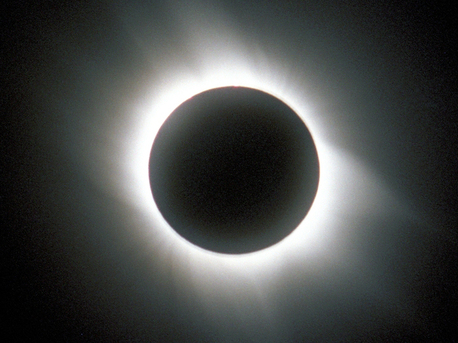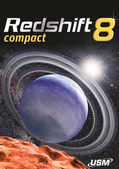The Sun's atmosphere
Does the Sun have a surface?
 © Ralf Künnemann (CC-BY-SA 2.5)
|
This photograph shows the Sun's corona, which only becomes visible to the unaided observer during a total solar eclipse. Then, the light from the photosphere is fully masked by the Moon.
The various layers of the Sun's atmosphere
The Sun's surface would no longer look at all smooth and round if our eyes could perceive ultraviolet radiation and X-rays. In these radiation ranges it becomes clear how the solar magnetic field continuously changes the shape of the Sun's atmosphere: features in motion on the Sun's surface, explosions of radiation and streams of matter which speed out into space for tens of thousand of miles. This layer of the Sun’s atmosphere, which can be observed with ultraviolet and X-ray telescopes, lies above the photosphere and is called the chromosphere.
The outermost layer of the Sun's atmosphere, the corona, can only be seen with the naked eye during a total solar eclipse. Then, the light from the photosphere is fully masked by the Moon. The corona is a 'crown of rays' with a temperature of over a million degrees Celsius, which usually has an asymmetric form – depending on the Sun's activity.
German Aerospace Center
The Sun's atmosphere
Does the Sun have a surface?
 © Ralf Künnemann (CC-BY-SA 2.5)
|
This photograph shows the Sun's corona, which only becomes visible to the unaided observer during a total solar eclipse. Then, the light from the photosphere is fully masked by the Moon.
The various layers of the Sun's atmosphere
The Sun's surface would no longer look at all smooth and round if our eyes could perceive ultraviolet radiation and X-rays. In these radiation ranges it becomes clear how the solar magnetic field continuously changes the shape of the Sun's atmosphere: features in motion on the Sun's surface, explosions of radiation and streams of matter which speed out into space for tens of thousand of miles. This layer of the Sun’s atmosphere, which can be observed with ultraviolet and X-ray telescopes, lies above the photosphere and is called the chromosphere.
The outermost layer of the Sun's atmosphere, the corona, can only be seen with the naked eye during a total solar eclipse. Then, the light from the photosphere is fully masked by the Moon. The corona is a 'crown of rays' with a temperature of over a million degrees Celsius, which usually has an asymmetric form – depending on the Sun's activity.
German Aerospace Center










